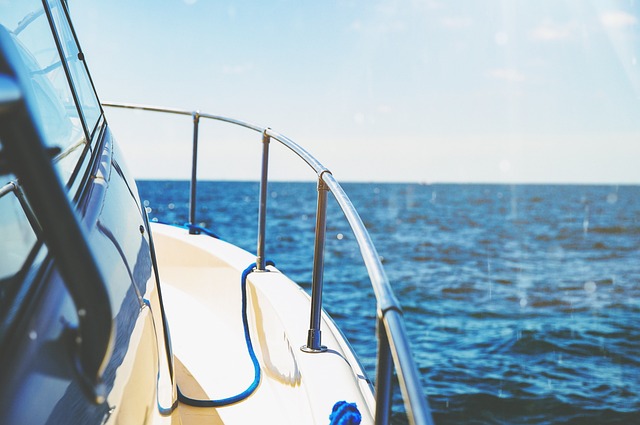Marine batteries are integral for uninterrupted power during maritime activities, with lead-acid, AGM, and lithium-ion types each offering unique benefits. Lead-acid batteries are robust but require regular water checks post-use, while AGM batteries are spill-proof and long-lasting. Lithium-ion batteries are lighter and more efficient, charging faster with longer lifespans. Proper maintenance includes selecting the right size, following charging protocols, avoiding deep discharges, and regularly monitoring state of charge to prevent sulfation. Storing batteries fully charged in a controlled environment can extend their life. For optimal performance, match the battery type to your vessel's energy demands, considering factors like capacity, amp-hours, reserve capacity, and cold cranking amps (CCA) for cold conditions. Regular inspections, maintenance checks, and monitoring of usage patterns are essential for longevity and reliable operation, ensuring your marine battery serves you well on every voyage.
5 Tips to Extend Your Marine Battery Life
Embarking on a journey aboard a vessel requires confidence in your boat’s systems, with the marine battery being the heart of power. To ensure your marine battery performs optimally and endures the test of time, this article delves into critical strategies for maintenance and management. From grasping the fundamentals of marine batteries to understanding the intricacies of desulphation, we explore a comprehensive approach to prolonging your battery’s lifespan. Learn how to maintain optimal charge levels, manage loads effectively, perform essential preventative measures, select the appropriate battery type for your needs, and establish a regular inspection and maintenance routine. With these tips, you can safeguard your marine battery’s performance and reliability on the open waters.
- Understanding Marine Battery Fundamentals
- Optimal Charge Maintenance for Marine Batteries
- Strategic Load Management to Prolong Battery Life
- Essential Preventative Measures for Marine Battery Health
- The Role of Desulphation in Maintaining Marine Battery Efficiency
- Upgrading to the Right Marine Battery Type for Your Needs
- Regular Inspection and Maintenance Checklist for Marine Batteries
Understanding Marine Battery Fundamentals

When it comes to ensuring your marine adventures are uninterrupted by power issues, understanding the fundamentals of marine batteries is paramount. Marine batteries, unlike their automotive counterparts, are designed to deliver consistent power in a variety of challenging conditions. They are typically lead-acid, AGM (Absorbent Glass Mat), or lithium-ion types, each with its own characteristics and maintenance requirements. Lead-acid batteries have been the standard for decades due to their high capacity and robust construction but require regular maintenance, including checking fluid levels and ensuring proper charging after use. AGM batteries offer a spill-proof design and longer lifespan, making them an excellent choice for those who prioritize reliability and ease of installation. Lithium-ion batteries are the newest entrant in the marine battery market, providing lightweight options with higher energy density, faster recharge rates, and greater cycle life. Understanding the type of battery you have on board is the first step toward optimizing its performance. Proper charging and maintenance routines, selecting the right size for your vessel’s power demands, and understanding the DoD (Depth of Discharge) are all critical factors in maximizing your marine battery’s life. Regularly monitoring the battery’s state of charge and avoiding excessive discharge will prevent sulfation buildup, which can diminish capacity over time. Additionally, storing your vessel properly when not in use, ensuring batteries are fully charged, and keeping them in a controlled environment can further extend their operational life. By familiarizing yourself with the specific needs and behaviors of marine batteries, you’ll be better equipped to maintain them, thereby enhancing the safety and enjoyment of your maritime expeditions.
Optimal Charge Maintenance for Marine Batteries

Regular maintenance and optimal charge management are crucial for the longevity of your marine battery. To ensure your battery operates at peak performance, it’s essential to monitor its state of charge regularly. Marine batteries, typically lead-acid or AGM (Absorbent Glass Mat) types, have an ideal voltage range between 12.6 volts and 12.8 volts when fully charged for a 12-volt system. Keeping the battery within this range prevents sulfation, a condition where sulfur crystals form on the lead plates, which can impair battery capacity and efficiency over time.
To maintain optimal charge levels, use a reliable marine battery charger with automatic float or maintenance charging capability. This type of charger maintains the battery at a full state of charge without overcharging, ensuring that the battery remains ready for use. It’s also important to regularly check the water level in lead-acid batteries and refill with distilled water as needed. For AGM batteries, regular checks are still necessary to monitor the battery’s voltage and condition, although they are maintenance-free regarding liquid electrolyte levels. By adhering to these practices, you can significantly extend the life of your marine battery, ensuring it performs reliably on every outing.
Strategic Load Management to Prolong Battery Life

To effectively manage the load on your marine battery and extend its lifespan, strategic load management is key. It’s important to understand the capacity of your marine battery and the power requirements of your onboard electronics. By carefully planning which devices are essential for immediate use and which can be powered down or turned off when not in use, you can prevent unnecessary discharge that leads to a shorter battery life. Always prioritize critical systems such as navigation lights, GPS, and VHF radio to ensure safety and legal compliance at all times. Additionally, avoid frequent on/off cycling of large appliances like refrigerators or entertainment systems, as this can put undue strain on the battery. Instead, plan their use during periods when the engine is running and the alternator is charging the battery, thus maintaining optimal charge levels. Regularly monitoring battery voltage and amperage draw through a multimeter can provide insights into your power consumption patterns, allowing for adjustments to be made to your load management strategy accordingly. This proactive approach not only prolongs the life of your marine battery but also ensures that you have reliable power when you need it most on the water.
Essential Preventative Measures for Marine Battery Health

To maintain optimal performance and prolong the life of your marine battery, it’s crucial to implement a series of preventative measures. Regularly inspect the battery for any signs of corrosion or damage to the terminals and connections; corroded terminals can significantly reduce electrical conductivity, leading to poor battery performance. Keep the battery clean by removing any accumulated dirt or corrosion with a wire brush, and ensure that the terminals are tightened to specifications to prevent loose connections.
In addition to physical maintenance, monitoring the state of charge is vital. Avoid discharging your marine battery below 50% of its capacity frequently, as deep discharges can shorten its lifespan. Use a battery monitor or regularly check the voltage to ensure the battery is not being overworked. Store the battery in a cool, dry place, and away from direct sunlight or extreme temperatures, which can adversely affect chemical reactions within the battery. Additionally, charge your marine battery properly; follow the manufacturer’s guidelines for charging times and amperage settings to avoid overcharging or undercharging. Regularly topping off the water levels in lead-acid batteries, if applicable, will also help maintain the battery’s electrolyte balance, which is essential for its health and longevity. By adhering to these preventative measures, you can significantly extend the life of your marine battery and ensure it operates reliably whenever you set sail.
The Role of Desulphation in Maintaining Marine Battery Efficiency

Regular maintenance and understanding the intricacies of your marine battery’s health are crucial for ensuring its longevity, particularly in relation to desulphation. This process involves the reversible deposition of sulphur on the lead plates within the battery. Over time, if not managed properly, sulphate layers can form on the lead plates, leading to reduced capacity and efficiency. To prevent this, it’s essential to keep the battery fully charged; most marine batteries are lead-acid types, which means they follow a simple charging principle: opportune charging prevents sulphation. Regularly using the battery under load also helps maintain its state of health by keeping the lead plates active and free from excessive sulphate buildup. For those who store their vessels for extended periods, consider partially charging the battery before storage to prevent open-circuit voltage conditions that can accelerate sulphation. By employing a battery maintainer or tender with a proper charge controller, you can effectively manage the state of charge and mitigate the effects of self-discharge. This proactive approach to desulphation management is key to maintaining your marine battery’s performance and extending its operational life.
Upgrading to the Right Marine Battery Type for Your Needs

When considering ways to extend your marine battery life, selecting the right type of marine battery is paramount. Each marine application has unique demands; thus, the choice of battery should align with these requirements to ensure optimal performance and longevity. For instance, deep-cycle marine batteries are designed to be frequently discharged and recharged, making them ideal for applications like trolling motors or boat electronics that experience regular use. On the other hand, starting (cranking) marine batteries are optimized for delivering short bursts of high current to start your vessel’s engine. Understanding the distinction between these types is crucial for performance and safety. Additionally, factors such as the battery’s capacity, amp-hours, and reserve capacity must be considered to match the specific energy needs of your marine equipment. Investing in a marine battery with a higher cold cranking amps (CCA) rating can also enhance starting reliability in colder climates. By carefully evaluating your vessel’s power consumption patterns and environmental considerations, you can select a marine battery that not only suits your needs but also contributes to longer battery life on the water. It’s important to consult with marine experts or refer to user manuals to ensure compatibility and safety for your specific marine application. Upgrading to the right marine battery type can significantly improve your boating experience by ensuring you have a reliable power source whenever you set sail.
Regular Inspection and Maintenance Checklist for Marine Batteries

When it comes to ensuring your marine battery delivers consistent performance, regular inspection and meticulous maintenance are key. A comprehensive checklist for marine battery upkeep includes monitoring the water levels in flooded lead-acid batteries, ensuring they are filled with distilled or deionized water as needed to prevent sulfation and maintain optimal electrolyte concentration. For maintenance-free batteries, inspecting the terminals and cables for corrosion and securing loose connections is essential to prevent voltage drop and ensure a reliable circuit.
Additionally, paying attention to the battery’s charge and discharge patterns can help you identify any irregularities early on. Regularly recording and analyzing amp-hours used during trips can provide valuable insights into your battery’s health and usage habits. It’s also important to store your marine battery in a cool, dry place when not in use, as extreme temperatures can shorten its lifespan. Always refer to the manufacturer’s guidelines for specific recommendations on maintenance procedures and expected battery life. By adhering to this checklist and understanding the nuances of marine battery technology, you can significantly extend the operational life of your battery and ensure it performs when you need it most.
In conclusion, maintaining a marine battery in optimal condition requires a comprehensive approach that includes understanding its fundamentals, consistent charge maintenance, strategic load management, and preventative measures to ensure health and longevity. Regular inspection and adherence to a maintenance checklist further bolster your vessel’s power supply. By upgrading to the right marine battery type for your specific needs and keeping abreast of desulphation techniques, you can significantly extend your marine battery’s lifespan. With these five tips in hand, your marine batteries will be well-equipped to handle the demands of the sea, ensuring your adventures are uninterrupted by power concerns.
